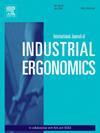背支撑外骨骼对腰椎负荷处理中身体不对称的影响
IF 3
2区 工程技术
Q2 ENGINEERING, INDUSTRIAL
International Journal of Industrial Ergonomics
Pub Date : 2025-04-26
DOI:10.1016/j.ergon.2025.103739
引用次数: 0
摘要
本研究调查了被动式背部支撑外骨骼(BSE)在涉及不同程度不对称的举重任务中对腰椎负荷的影响。12名健康的参与者完成了不同程度的不对称(90°,135°,180°)的举重任务,有和没有外骨骼。评估外骨骼对L5/S1三维力矩和骨盆方向的影响。结果表明,无论不对称程度如何,BSE都能有效降低L5/S1延伸矩(5 - 11%)。正面和横平面力矩不受外骨骼支撑的直接影响,而是由于任务执行的变化而减小。这包括骨盆更倾向于抬举方向,尤其是在任务不对称性增加的情况下。研究结果表明,测试的疯牛病可以在非对称任务中提供有意义的支持,沿着它的一个驱动自由度。在评估它们在实际应用中的可行性时,应该考虑任务执行中的适应性。建议进一步研究在现场条件下并结合用户接受程度来验证这些效果。本文章由计算机程序翻译,如有差异,请以英文原文为准。
The effects of body asymmetry in load handling with a back supporting exoskeleton on lumbar loading
This study investigated the effects of a passive back support exoskeleton (BSE) on lumbar loading during lifting tasks involving varying levels of asymmetry. Twelve healthy participants completed lifting tasks with different levels of asymmetry (90°, 135°, 180°) with and without the exoskeleton. The exoskeleton's influence on 3D L5/S1 moments and pelvis orientation was assessed. Results demonstrated that the BSE effectively reduced L5/S1 extension moments (5–11 %), regardless of the level of asymmetry. Frontal and transversal plane moments were not directly influenced by the exoskeleton support, but instead reduced due to changes in task execution. This included orienting the pelvis more towards the lifting direction, especially with increasing task asymmetry. The findings suggest that the tested BSE can provide meaningful support during asymmetric tasks, along its one actuated degree of freedom. Adaptations in task execution should be considered when evaluating their feasibility for real-world use. Further research is recommended to validate these effects under field conditions and in combination with user acceptance.
求助全文
通过发布文献求助,成功后即可免费获取论文全文。
去求助
来源期刊
CiteScore
6.40
自引率
12.90%
发文量
110
审稿时长
56 days
期刊介绍:
The journal publishes original contributions that add to our understanding of the role of humans in today systems and the interactions thereof with various system components. The journal typically covers the following areas: industrial and occupational ergonomics, design of systems, tools and equipment, human performance measurement and modeling, human productivity, humans in technologically complex systems, and safety. The focus of the articles includes basic theoretical advances, applications, case studies, new methodologies and procedures; and empirical studies.

 求助内容:
求助内容: 应助结果提醒方式:
应助结果提醒方式:


